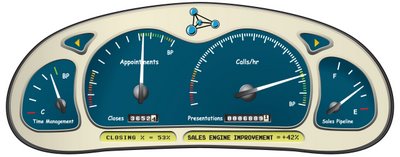Sales Co-Creation
One of the most glossed over facts in all of sales improvement seminars, webinars and literature is what part the customer plays in the final outcome. The “experts” spend the majority of their time telling us how to improve this skill or that talent. However, they spend an inordinately small amount of time talking about the customer’s role in completing the sale. That ends here.
In the Beginning
Let’s think about how a customer becomes aware of our product or service. They may have seen some form of advertisement or heard by way of a third party, but in the end it almost always boils down to FIRST contact with the sales person. Now tradition dictates that we do “X, Y and Z” on an initial call, email, snail mail, social media, etc. yet what is it that the customer wants from the experience?
I state UNEQUIVOCALLY a customer wants to be educated NOT SOLD. They want the sensation of learning without feeling manipulated. Most customers believe they can make the best decision possible… they just lack the right information. When educated, they can share this information either positively or negatively with others in the company and disseminate the info how they see fit.
When we become a resource to the customer we correspondingly INCREASE our worth to them. Becoming somebody they come to trust to provide valuable information. Our calls seem less like drudgery and more like an opportunity. Our emails are potential founts of information and every customer/prospect touch has increased value. This is how we want to start EVERY prospect interaction.
We Trip On What We Don’t See
Every customer is unique, each having a distinctive sales cycle and timetable. Yet, sales gurus will teach 100’s of different selling processes and NOT ONE of them is based on how the customer wants to purchase.
Instead what you have are salespeople who blame the prospect for their woes
- The un-returned call
- The canceled meeting
- The objection
You name it; it’s ALWAYS the customer’s fault. The lack of introspection on the behalf of sales is alarming but worse are the supposed gurus of sales that pedal this garbage. Sales Co-Creation begins and ends with accepting responsibility and fixing what you break, just like in ANY other relationship in your life.
We need to understand their process. What they are going through. What they need to make the sale happen. There will be speed-bumps if not outright road hazards all the way through, but the only way to finish the race is to KNOW what they need to make the sale happen. From internal politics, to budgets, to how decisions are made, we need to be an EXPERT on their processes not just our way of selling.
When we take the time to learn THEIR processes we get to know them. We learn the best times and methods of staying in touch and keeping top of mind. But the biggest thing we accomplish is being hassle-free . We can become the 1 thing that DOESN’T give them agita because we will know everything that does.
AMF: Always Move Forward
Your goal is not to make a sale each time you contact a customer (it would be nice it’s just not very probable). Your focus is on PROGRESSING the sale.
Not continuing the sale, but PROGRESSING the sale.
If you 1st become a valued resource to your customer and 2nd have learned their buying process to the point you alleviate problems, you will have EARNED the right to move the sale forward at every juncture.
What did you do before making initial contact calls?
- Send the prospect relevant articles about their industry?
- Inform them of a free webinar given by an industry expert that will help in their job?
If you did, when you call they’ll probably remember you if not be appreciative of your efforts.
What did you do before your first in-person meeting?
- Research the company and their industry?
- Gain a basic understanding of the issues they face everyday?
If you did, the meeting will be sharp and the customer will appreciate the preparation you did so you aren’t wasting their time.
And on it goes. At every step in the process you have to BRING IT! Go over and above and EARN the right to keep the sale trundling down the path of conversion. It’s not easy, if it was easy everybody would do it that’s why it will work!
Folks, that’s it.
1) Educate and become a RESOURCE to the customer
2) Be Hassle Free by learning THEIR process
3) PROGRESSION: Earn the right to AMF: Always Move Forward
Co-Creation of the sale means you have to think like a customer! What do they want? How do they want it? They are at least 50% of the equation, don’t force some pre-conceived sales process from the latest hot trend. Learn to look at the sale through their eyes, it is a much better view than from your computer.
Everybody is BUSY!
There is a great scene in Seinfeld where George is talking to a character about being busy and I’ll be dipped if it isn’t what we all would LOVE to say to our customers. You can view the clip here (Busy, Busy, Busy) Pinpoint as usual from George. Customers are always busy. We are always busy.
It is great to be busy. We have all kind of projects going on and meetings to go to. The only problem is when all that “busyness” actually holds you back from taking the next step in REALLY growing your business. Before long you blink and the 1st quarter of the year is gone. You say to yourself “well at least we closed ‘X’ amount of business” The RIGHT question is “how much business COULD you have closed?”
How & Why We Get Trapped
I have seen and been on the front-line of this very phenomenon in multiple industries, the cable (TV) industry in the late 90’s, electronic components in the mid 00’s and construction/building products in the late 00’s to name a few. Here’s the problem, you are so busy with day to day activities, doing the immediate pressing tasks you never find the time for the proactive, big picture, revenue boosting activities that can drive your sales for months and years to come.
You tell yourself you’ll get to it eventually but the sad truth is you NEVER do. You simply move on to the next immediate task all the while thinking to yourself that you feel like a hamster on an exercise wheel. The question is HOW do you break out of the rut and move things forward?
Listen to NIKE
There is NEVER an actual perfect time so do it NOW! FORCE yourself to evaluate what is going on. Decide on what activities are needed, what tactics/strategies should be employed, and then execute.
Speed is What We Need!
The effective use of speed is critical and clearly a competitive weapon. Move fast, or become HISTORY as everything you do increases your competitive position or moves you one step closer to being competitive toast.
Confronted with a constantly shifting array of customers, competitors, strategic alliances, technology and market volatility, the only hope for increased productivity lies in developing the ability to move and change at least as rapidly as your competitive environment.
The company or individual that does not embrace the importance of speed will be HAMMERED.
In fact, as a strategic weapon, speed is the equivalent of money, productivity, quality, even innovation.
Pretty simple formula, but as everything the trick is in the execution. You’re busy I get it, but it is time to make a decision. Are you too busy to improve your business or are you willing to look past the immediate and recognize what has to happen to keep your business growing?
Your choice….
What are the Metrics that Matter?
Most Sales Departments stink when it comes to tracking their numbers. The question upper management ALWAYS asks is why? My two cents; we don’t know the most important numbers to track and we don’t realize how important they are to our entire selling effort. Well, those excuses end today!
Indicators
The first area that we need to clear up is the difference between trailing and leading indicators. Trailing indicators refer to metrics that happen as a RESULT or in the past. Number of sales closed or total dollar amount closed are examples of the trailing variety. Leading indicators are what foretell objectives and what results will be in the future. The activities that a sales person performs on a daily basis, such as phone calls or appointments, are examples of leading indicators.
We always need to know how many and how much business has been closed (trailing) but we can’t control the actual closing of the sale. That is why we can never lose sight of the activities (leading) it takes to fill the pipeline and, more importantly, directly affect the closing of the sale. This is crucial to short and long term forecasting accuracy and critically more important to overall SALES SUCCESS.
Leading Metric Indicators
I first focus on the BIG 4 of Leading Metric Indicators (LMI’s): Calls, Discovery Appointments, Presentations and Closes. These are pillars of a sale that will tell you the overall picture of what is working, why it is working and what needs to be fixed.
The next LMI’s that I track are more descriptive of the sales reps everyday work.
- How many leads (non-qualified contacts) are they working on?
- How many opportunities (qualified contacts in the buying cycle) are they working on?
- What type of accounts are the reps calling on?
- What is the job function of their main contact?
If the BIG 4 gives you the overall picture, when you drill down to this level you uncover more of the texture in the everyday activities of your sales team. Not just the raw numbers but WHY you are getting the raw numbers. When we understand both sets of LMI’s and their conversion rates it helps us to more accurately predict closing rates in the near and long term.
Trailing Metrics Indicators
I always track total number of closed sales and total sales dollars. They are important and necessary to measure where we have finished historically, yet it always amazes me what sales management forgets to measure in the Trailing Metric Indicator (TMI) category.
A.U.S.P. or average unit selling price is the total sales dollars divided by the total number of sales. For example if total sales dollars are $100,000 and total number sales are 10 your A.U.S.P. equals $10,000. Knowing this number tells you how many sales it will take to hit your objective. This TMI is key to planning your goals and objectives throughout the year.
The final TMI I track is Average Velocity of Sale or the A.V.O.S. This is the average time from when a lead becomes an opportunity to when it converts to a sale. Having the handle on this metric allows you to realistically plan WHEN your business is going to hit.
Wrap Up
12 chapters of data making up one book; lose one of the chapters and you wonder how and why things are happening. Lose two chapters and the story starts to sound nonsensical. Lose three and you wonder why you started reading the book at all. 12 categories of data when monitored and measured can radically affect your sales team’s short and long term success and viability.
Sure it takes time and getting sales to record their info is difficult. Keeping up with the numbers is a job in of itself. I have heard all of the excuses before. I leave you with a question. If you could produce a set of numbers telling you how to improve, what to improve and when to improve your sales results wouldn’t you want to know them and wouldn’t you do everything in your power to track them? Yea, I don’t know either…
Be Hassle Free
I was clicking through the cable stations the other night and settled on a rerun of “The West Wing” for some background noise. Not particularly paying attention until toward the end of the episode I heard a line from the character of ‘Danny Cocannon’ talking to ‘Charlie Young’.
Charlie was lamenting dating the President’s daughter because of various issues, I couldn’t tell you what (again background noise). Then I heard Danny say “If it was me I would want to be the one hassle free person in her life” BOOM. Isn’t that EXACTLY what we should be to our customers?
(You Can View the clip here Be The 1 hassle free Person)
We should be the one hassle free thing in our customers’ life. As salespeople we spend most of our time strategizing on how to find the customer, how to question the customer and how to negotiate with the customer so we can win the sale. What if INSTEAD we spent a little more time thinking about things from their perspective?
Our customers, by definition, have to be decision makers. As a general rule, they must have some level of authority and responsibility. So what daily tasks, problems and ordeals accompany those two duties?
- 100’s of phone calls
- 100’s of email
- Management reporting and meetings
- Employee problems
- Internal power struggles
- Logistical challenges
- Other vendors issues
- Personal issues
I know what you might be thinking. “My boss doesn’t care about these things” or maybe “I have quota to make I can’t worry about their problems.” Well I am here to tell you if you don’t worry about their problems you will NEVER solve your own!
There are 1000’s of things that can crop up at any time for our customer and we are only ONE of them. The patience and professionalism we exhibit in working our way into customer’s daily schedule will determine how they perceive us and ultimately the level of success we experience.
Below are 5 ways we can Be Hassle Free in the face of these daily dilemmas:
- Only call if you have a REASON or NEED to call, not because “I just wanted to…”
- Email if you have something relevant, helpful, informational etc. not the joke of the day or “I was just checking in.”
- Respect their time! Recognize you are only one small part of their day and make the time you share with them COUNT. Be prepared for every meeting, phone call and presentation. Never waste their time.
- If they choose to share any problem situation with you tread carefully. YouARENOT the business equivalent of Dr. Ruth, but you can find information online that might address their concerns.
- Be humble and empathize but DO NOT commiserate. Realize there will be problems you can’t help with but let them know you understand their situation and will be as supportive as possible.
It comes down to this; we need to find a way to become a POSITIVE in the customer’s day. Whenever they see your number on caller ID they should want to take the call because they know you will share something of value with them. You might be calling with an idea or with information about their industry or maybe even a solution to their problem. Whatever it may be, they have to WANT to talk to you.
Be the one hassle free thing in their daily existence; an oasis from the desert of problems they face. Provide valuable resources and make their life easier. Find something they need that has NOTHING to do with your business and HELP THEM. You have to go OUTSIDE your job description and do things your competitors wouldn’t even think of if you truly want to help people.
It is a lot of work I know but I promise, if you do, the business relationship will grow and your sales will skyrocket. It is a choice you have to make everyday so choose wisely, the job you save just might be your own.
The 3 Keys to a Successful Sales Process
About this time of year, a lot of sales managers/executives are thinking about the New Year and the sales goals they have been assigned. They are wondering what they will have to do to hit their numbers and I guarantee a good percentage is thinking about establishing a new selling process.
They are reading every new book on sales and the selling process trying to get the edge they need to make their 2012 goals. I am here to tell you that it does not matter WHAT process/system is adopted if the 3 Keys don’t exist within your team then Tony Robbins, Tom Hopkins and Zig Ziglar COMBINED won’t be able to help you.
Key 1: 100% Management Commitment
No selling system will succeed unless the front-line managers are 100% committed and have bought into the process. If they can’t support and reinforce its implementation you will need an egg timer to see how fast it will fail.
Leadership defines what a selling system should involve but also must be it’s #1 proponent and example. Investigating the sales models available cannot be taken lightly. If you are going to invest your company’s time and money in a sales system it must be in harmony with the culture necessary for successful selling.
A key to successful sales force transformation is a conceptual shift on the part of first level managers from reactive to proactive. If frontline managers don’t grasp this most basic concept you have the wrong people and are in a world of hurt.
Key 2: Sales Force Adoption
Most sales training fails because it’s the business “flavor of the month” with a ready, fire, aim mentality. Many training programs consist of “read this book” or attend this two-day training session. There is nothing wrong with the material and the information from these sources. But nobody learns, retains and uses information this way. If we did, we would all have our MBA’s in six months.
Look at professional training in various fields. A welder or electrician spends a minimum of a year learning their craft, pilots must log hundreds of hours in the air before they get their license, and so on.
Generally, we give salespeople a briefcase and say: “Go get ’em.” It’s an insult to our clients and to the profession of sales, but it is also not going to help you or your salesperson hit your target. Installation of the all phases of the new system will require in various amounts
- Lecture
- Simulation (practicing)
- Experiential (observation)
- Practical (work in conjunction)
- Actual (doing the job)
- Testing
- Ongoing Coaching
These are essential elements to ensure adoption. If you aren’t willing to commit resources to these activities DON’T bother changing.
Key 3: Support and Reinforcement
Even the best selling system, delivered by the most entertaining and persuasive facilitator, will be a distant memory within a few weeks if the effort is not ongoing. It’s fine that your salespeople know what to do, but to do it under pressure in buyer/seller situations requires that a salesperson graduate from knowledge to mastery.
The availability to continue the learning and support process is crucial to the installation’s success. Remember, selling is a high-rejection business. You must constantly monitor, measure and modify based on the results you are seeing. Techniques will need to be tweaked, attitudes boosted and continual encouragement dished out when you see signs and successes of productive behavior.
In short this is a monumental undertaking and if you perceive it to be anything but you are making a colossal mistake.
Wrap Up
Folks, I am not trying to discourage you from changing your system but I am trying to alert you to the myriad issues that you will be facing. We are talking about how a company makes a profit and people earn a living, there will be speed bumps.
I have personally seen the rewards of the right system having been implemented in the right way and trust me when I say they are nothing short of transformational. Your company experiences growth, and most importantly your sales team experiences new levels of success they never thought possible, it is glorious when done right. So do your homework, prepare your team and settle in for some of the hardest work of your life, but believe me, IT IS WORTH IT!
You Might be a Commodity if….
Most of us remember Jeff Foxworthy’s famous routine “You might be a redneck if…”
- You think “loading the dishwasher” means getting your wife drunk.
- You ever cut your grass and found a car.
- You own a home that is mobile and 5 cars that aren’t.
Just a sample of his more memorable lines to jog your memory (and because I couldn’t resist).
Well, in sales, we have an affliction that is far less funny and much more tragic. When our customers think of us as a commodity they either can’t or don’t perceive the difference between us and our competition and/or they have ZERO recognition of the value of our product/service. I don’t know if there is a more deadly one two punch in sales.
So, in the spirit of Jeff Foxworthy here is a list of some of the most common and DANGEROUS signs of this affliction.
You might be a commodity if…
- After a lead generation campaign, when calling prospects, they don’t recognize your name or your company or worse when they hear your name you hear “UGH, oh Hi John…”
- If you try to set an appointment with a prospect and she says, “Tell you what call me back in a week and I’ll let you know what I want to do then.”
- After the initial discovery appointment the customer tells you thanks for your time and he’ll be in touch.
- During the presentation you ask your prospect what he likes best and he says “Good question” yet never answers you.
- You find yourself negotiating your price on 2 out of every 3 closing presentations.
- Before the presentation they told you they needed to make a decision by next week and now it is next month and you still have not been able to get them on the phone.
- After the presentation you attempt to schedule a next step meeting and your prospect says, “I think we have all the information we need.”
- Calling to schedule a next step meeting your prospect says “what was this about again?”
- You go to a networking function of 100+ people and you don’t come back with ANY actionable leads.
- The closest you get to an opportunity at a trade show is somebody who comes to your booth for the free candy and chotchkies.
We have a webinar coming up on Wednesday December 21st that will offer some cures to this deadly disease and in the meantime, check you and your team for these symptoms. If any of these have manifested themselves my prescription is to attend our webinar and call me in the morning.
You Train Animals, People Want to Continually Develop
How are you ensuring continual growth and improvement for both you and your team?
Good performance can sometimes keep people from aggressively pursuing even higher levels of improvement and contribution to their companies, their customers, and even to themselves.
Good becomes the habit. Great becomes unnecessary. Or in other words, ‘Good becomes the NATURAL enemy of Great’ as Jim Collins says in his landmark 2001 book named aptly “Good to Great”
This is the problem, but why does it happen?
We all want to be good in sales; this is also my concern. We form habits that will keep us merely good. We have to push past what we are currently doing if we want to reach the GREAT. The question is HOW and for some of us WHY.
First the How
We must CONTINUALLY lead our sales team to stretch their talents both in sales production and sales education. Bottom-line is if you aren’t stretching you aren’t leading. The good news is the top 7% of reps will be salivating at a chance to grow their skills and will welcome this formal opportunity.
The “good” to “average” reps might need some encouragement. The only way to do that is to KNOW your team and what are they capable of. You must know what motivates them, what will make them jump through fire to achieve. Then give them the nudge they need to go past their comfort zone by developing goals and business skill development tasks that will nurture the qualities leading to their personal growth and future success.
Remember you need to be their leader not just their manager. Get out in front of this effort by setting your own stretch goals and business development tasks. Sales people and people in general abhor those who don’t “walk the talk”. There is nothing more common than a salesperson “outgrowing” their sales manager because he simply stopped developing as a professional and can no longer keep up with them.
The best part of this initiative is its natural byproduct, improving the bottom line. And seriously, unless we improve what we are doing and how we are doing it we will remain “effectively stuck in neutral” and I promise, somebody or everybody will catch up and we will start to lose business, market share and maybe our career.
Now let’s talk about the WHY
We all go into sales for different reasons. For some it’s the ability to be compensated based on our performance. Others like the autonomy and still others see it as a fast track to management and beyond. But the bottom line is we all want to make more money than a simple base salary and that can’t happen unless we improve daily what we are doing and how we are doing it. I also don’t believe for a minute anybody who is TRULY a salesperson wants to stay status quo. That’s why you see so many athletes in sales, the competition to be the best, to keep their edge, can be the “juice” as well!
You see it’s been my experience that across the board REAL, TRUE salespeople are exactly the same. They are the richest, have the most connections and are the best in their respective “sales circle”. Here’s the twist though, in my classes I teach this caveat, “Customers don’t buy features, they don’t buy what the features do; they buy what the features will give them”. Or as Charles Revlon famously said “In the factories we make cosmetics and in the stores we sell hope”. So I don’t believe it’s JUST the accumulation of MORE money, it’s what the money will provide us. New car, boat, house payments, tuition and the peace of mind that we can PAY for all those things comfortably, that’s what money gets us.
The bigger reason I think is this; REAL TRUE salespeople are ULTRA competitive, they want to be acknowledged as the BEST but what they also want, if for only once in their life, they want to be part of something GREAT. They want to know that if not for their efforts that GREATNESS would not have been achieved. They want to be a difference maker, a game changer; the person that pushes whatever their endeavor to new heights.
You see, GREATNESS stays with a person. It changes a person in every tangible and intangible way; how they talk, make decisions, heck, even live their life because they know they were an integral part of something GREAT. You’ll never go back to how things were before because now you know how things can be, and isn’t that what we all want?
That’s it for now and remember you can either make sales or make excuses but you can’t do both!
Instant Lead Generation: The Structure of an Effective Case Study
We all want to write about our successful exploits so potential customers may learn from what our established customers have experienced. The problem is we often lack the most effective way to get our message out. We also fall prey to the inability to explain the impact, results and ROI so value is immediately understood and ROI is instantly perceived.
Following the Matrix Case Study Structure will ensure your potential customers understand the “story” while also realizing the TRUE ECONOMIC effect of your solution.
1) State the Business Problem in plain language, the simpler to understand the better. Stay away from clever turn’s of phrase or industry specific vernacular (words like vernacular for example).
2) The Consequence of not fixing the problem MUST be stated ASAP, if not the question in the reader’s mind is “Why am I wasting my time?”
3) The Reward of the fixing problem must be stated IMMEDIATELY after the Consequence. Readers are tuned to radio station WII FM “What’s In It For Me?”
4) Explain the specific results the customer received as a by product of the implementation, making sure you “speak” in dollars and performance as well as systematic/procedural improvements.
5) Discuss any business lessons learned through the prism of explaining the solution. Don’t leave out any “warts” in the implementation. This level of disclosure will establish trust regarding you personally and your results.
6) Wrap up with a CURRENT snapshot as to how well the current customer is doing (complete with dollar and systematic/procedural updates) or with a simple conclusion of the experience.
Some folks LOVE the Call to Action Premise, “If these are the types of issues you face and results you want please contact us at…” I tend to NOT use them because they are obvious. You should always be following up TELE-PHONICALLY when you are aware of somebody requesting/downloading etc., a case study so a call to action is moot if you are ON your game.
Each contact you make should be progressing the relationship just don’t forget to ask for feedback about the case study. If they were not compelled to contact you by its presentation why not? What can you do differently? What are they looking for? Be responsive and listen to your customers and potential customers. Make your tweaks, rinse and repeat and start counting your cash….
Everything I Ever Needed to Know About Sales I Learned From the Movies: Monsters, Inc.
3 Sales Management Lessons From
The Power of Practice
We all think we are sooooo great! Just wind us up, do a little preparation and let’s go talk to customers. Well the scary characters in Monsters, Inc. would tell you different. Scaring is critically important in their world because the “screams” that come from the children they scare power their city, lights, heat, cars you name it.
The first scene in the movie shows their training area where they practice “scaring.” They have a replica child’s room complete with a “little boy” robot. One of the “professional scarers” comes out of the closet to scare the little boy and he makes some serious mistakes. It is prime learning time for the all monsters on the team because they video tape the simulations. Now they can go back and coach/correct all the mistakes. It helps the individual monster making the mistakes and all the other monsters on the team.
Sound familiar? Folks you are making a gravely serious mistake if you do not conduct simulations with your team. Make them as real to life as you possibly can. Video tape them so you can document progress or regression. Make the simulations part of your weekly/monthly/quarterly sales meetings. Make them fun, have contests around them. But most of all DO THEM!
You should also practice presentations with every rep individually. Don’t leave anything to chance. Give your rep the best shot possible by running through the discovery/presentation/negotiation with them BEFORE they go to it. George Patton, one of our greatest generals of all time, said “Sure I am tough on them during training! I much rather they sweat with me than bleed on the battle field.” Well, I rather my sales people learn in an office from me so they are prepared to get the sale, than by learning a lesson with a client and losing the sale.
The Power of Naming
About half-way through the movie there is a scene where the two main characters, Sully and Mike, are trying to send home the little girl who snuck into the Monster’s world. They are arguing about how to do it when Sully says that he has named her “Boo.” Well Mike is just livid at this development and he says, in a very angry voice, “You named it? You can’t name it; once you name it you get attached to it.” Exactly, once we take the time and effort to name something we begin to place value on that something. It is the reason why I tell all my clients that they should name their proposals.
What is special about an ‘Investment Analysis for ABC Company’ or what about ‘A Proposal for Electronic Payment Services Prepared by Joe Smith Company’? Answer: NOTHING. Both sound as generic as the proposal inside, I would wager. That is why I am amazed when sales management does not make formally naming proposals an air tight rule for every proposal that goes out the door.
The proposal is supposed to be a professional selling document not a glorified descriptive invoice. NAME YOUR PROPOSAL based on what the prospect wants as a RESULT of buying your products and services. A couple of examples I have used:
- “How to Improve your Sales Team While Increasing Sales Revenue”
- “Increase the Productivity of your Customer Service Team and Watch your Sales Soar”
- “Creating a Lead Generation System that Produces an Ongoing Stream of Quality, Qualified Leads”
Each one of the above Proposal Names tell the prospect EXACTLY what to expect from reading the proposal but more importantly each name tells THE VALUE that comes from implementing what is inside the proposal.
The Power of Laughter
Remember when I told you that a child’s scream was the source for power in Monster City? Well by the end of the movie Sully and Mike learn that laughter is 10 times more powerful than a scream so they completely re-engineer Monsters, Inc. Now each monster who visits a child’s room has to make the children laugh instead of scream and the result is a record breaking year for energy production.
Managers, find a way to make sales fun for your team. Have contests, pit individuals against each other, get your team to volunteer for community events or hold them yourself and ALWAYS celebrate victories with your team. Take them out for cocktails or dinner or both, take them bowling, take them to an amusement park, it doesn’t matter what you do, the effort here COUNTS, but try to have fun with your team.
I know you need to maintain a certain professional distance from the team. If you get too close it can cloud your judgment or worse cost you a great sales person or a big sale. I am also aware there is always going to be the need to be tough with your team. There will also always be the need to place corrective actions on 1 or more members of your team. That’s fine just don’t let your managerial brio get in the way of having your team enjoy themselves.
Remember laughter is 10 times more powerful than screams keep that ratio in mind and you will be amazed at the results.
Relationships, Slips and Dips
I was at a customer’s last week starting to dig into the Strategy Module for a S.I.T. Blitz we will be conducting the 2nd week in September. Working with the salespeople, we always go through a series of questions to understand their perception of the suspect/prospect/customer (SPC) dynamic which is so crucial when planning for a successful S.I.T. Blitz.
One of the key factors is knowing their standard for SPC communication in terms of frequency. During the course of questions one salesperson chimed in and said “I keep in touch with my suspects and prospects 2x a year, any more than that and I think it would appear pushy.”
Well after the black cloud and threat of lighting inside the building passed I asked him how often does he talk to his best friend? He said probably 2 times a week. Then I asked how often did he call his wife when they were dating? He said minimum 4 times a week. Then I asked him if he considered his relationships with his contacts as solid and he said yes, emphatically, I might add.
So I think you know where I was going with this line of questioning. My final question to him was how many times has he called one of his contacts only to find out that his contact person wasn’t there or there had been a drastic change in the company. His answer “John, more times than I can count,” and therein lies the ‘problemo’ my sales friend.
Believe it or not this happens to me about once a month; a salesperson who understands staying in touch with friends or girlfriends, but doesn’t have a clue what it takes to maintain a successful business relationship. Strangely enough, these same sales people will argue, ‘till blue in the face, they have a good feel for their customers.
I call the first level of this problem Relation-Slip behavior. The sales person “thinks” they know how to stay in touch with a contact. The problem is what they “thinks” has nothing to do with the facts, needs and wants of the suspect/prospect/customer so what winds up happening is a deepening chasm develops between sales and contact with sales being quite oblivious to it. There is a ALWAYS correlation with a drop in sales but the sales person is stuck scratching their head and wondering why this is happening to him.
The next level DOWN is Relation-Dip behavior. The sales person here doesn’t have a clue how to stay in touch with their contacts. They will never admit they have a problem, so they go the other direction and MINIMIZE contact to the point of neglect. You see, in their mind, by not “bugging them” they are maintaining a good relationship. These sales people are so afraid of experiencing the UGH Factor that they will stay away from the suspect/prospect/customer. My question is “If you stay away for long periods of time how will you know when they have become a ripe prospect?” Insert collective silence or righteous indignation ‘here. Then you add the precipitous drop in sales and you have yourself a major issue.
Like any problem in sales early recognition is key. If you are a sales manager WAKEUP! You should be tracking not just their sales production but their lead generation activities. Either one should give you enough of an alert to intervene before the behavior jeopardizes their career and your quota attainment.
If you are a sales person WAKEUP! Your sales are down! Either you don’t spend enough time staying in touch with your customers or you are doing the absolute WRONG things. You have to be self aware enough to say “I have to change what I am doing or this sucker is going down!”
All righty then…. that’s it for today! Next post I will be talking about the solution to Relation-Slips and Dips and the changing nature of the sales contact process.
Until then remember “You can either make sales or you can make excuses but you can’t do both…” I’m outta here!
If you want more information about the S.I.T. Blitz and how you can have a “revenue raining, climate change” experience at your please call Matrix at 216 347 6729 or go to buildyoursalesmachine.com for more details!
Archives
- May 2018
- November 2016
- June 2016
- April 2016
- March 2016
- February 2016
- January 2016
- February 2012
- January 2012
- December 2011
- October 2011
- August 2011
- July 2011
- June 2011
- May 2011
- April 2011
- March 2011
- February 2011
- July 2009
- June 2009
- May 2009
- August 2008
- June 2008
- May 2008
- April 2008
Categories
- A-Players
- Best Practice
- Change
- Cold Call
- Communication Skills
- Continual Development
- Critique Session
- Customer
- D.I.G.
- Drive
- Firing
- Guts
- Handling criticism
- Hiring and Assessment
- Hiring Dashboard
- Human Resources
- Intelligence
- interview questions
- Interviewing
- interviewing sales superstars
- Lead Generation
- Leads
- Motivation
- Naturally Curious
- New Contact Touches
- Position Contracts
- Proposals That Sell
- Prospects
- Reference Checks
- S.I.T. Blitz
- S.I.T. Nurture Prospecting System
- S.I.T. Touch
- Sales 3.0
- Sales Blitz
- Sales Management
- Sales Superstars
- Simulations
- Skill Sets
- Staffing
- Suspect/Prospect/ Customer Dynamic
- Suspects
- Talent and Traits
- Termination
- Uncategorized










